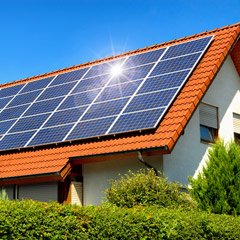Go Green, Save Green: Tax Breaks for Saving Energy
April 30, 2018 | IRS Regulation, Tax Planning, Tax Preparation
 April 22 was Earth Day. It’s a great reminder to consider implementing changes to help reduce the amount of energy we consume. But “going green” isn’t just good for the Earth — certain energy-saving expenditures also may qualify for generous tax breaks that are good for your pocketbook, too.
April 22 was Earth Day. It’s a great reminder to consider implementing changes to help reduce the amount of energy we consume. But “going green” isn’t just good for the Earth — certain energy-saving expenditures also may qualify for generous tax breaks that are good for your pocketbook, too.
Here are some tax credits for buying and installing certain types of energy-efficient residential equipment.
Current Tax Breaks for Green Equipment
You may be eligible for a tax credit of 30% of expenditures on your 2017 through 2019 returns, (including costs for site preparation, assembly, installation, piping, and wiring) for installing the following items:
- Qualified geothermal heat pump equipment,
- Qualified solar electricity generating equipment and solar water heating equipment,
- Qualified wind energy equipment, and
- Qualified fuel cell electricity generating equipment (limited to $500 for each half kilowatt of fuel cell capacity).
The credits can be substantial since these items can be expensive. And there are no income limits. Even billionaires are eligible. To qualify, the equipment must be installed at your U.S. residence, including a vacation home — except for fuel cell equipment, which must be installed at your primary residence. For equipment installed at a property that’s used exclusively as a rental, you can’t claim credits.
No credit is allowed for solar water heating equipment unless it’s certified for performance by the nonprofit Solar Rating & Certification Corporation or a comparable entity endorsed by the state in which your residence is located. (Keep this certification with your tax records.) To qualify for the credit for solar water heating equipment, at least 50% of the energy used to heat water for the property must be generated by the solar equipment.
In 2020, the credit rate for these expenditures drops to 26% and then to 22% in 2021. After that, the credits are scheduled to expire. These credits can be used to reduce your regular federal income tax bill and the alternative minimum tax (AMT) if you owe it. You might also be eligible for state and local tax benefits, subsidized state and local financing deals, and utility company rebates.
Credits for Minor Energy-Efficient Installations
If you had other qualifying expenditures last year, then you can claim a more modest residential energy credit on your 2017 return. This break — which expired at the end of 2017 — has a lifetime maximum of $500 and covers qualified expenditures for:
- Advanced main air circulating fans,
- Biomass fuel stoves,
- Electric heat pumps and electric heat pump water heaters,
- Energy-efficient insulation,
- Energy-efficient roofing products,
- Energy-efficient windows, skylights and doors,
- High-efficiency central air conditioners,
- Natural gas, propane, and oil furnaces and hot water boilers, and
- Natural gas, propane and oil water heaters.
Claiming Your Credit
You can only claim green tax credits for expenditures on a “home,” which can include a house, condo, co-op apartment, houseboat, or mobile home, or a manufactured home that conforms to federal manufactured home construction and safety standards.
Keep proof of how much you spend on qualifying equipment, including any extra amounts for site preparation, assembly and installation. Also keep a record of when the installation was completed, because you can claim the credit only for the year when that happened.
Important: Even if you’ve already filed your federal income tax return for 2017, you may be able to file amended returns to collect the tax savings. Ask your tax advisor for more information.
Need Help?
Based on technological developments and green policy initiatives in Washington, D.C., green tax breaks change from year to year. Contact your tax advisor to help you understand the ever-changing rules and maintain records to support any tax credits you claim for installing energy-saving equipment in your home.
